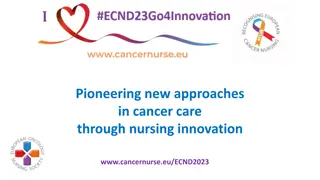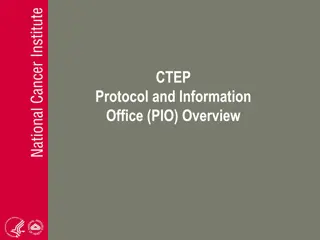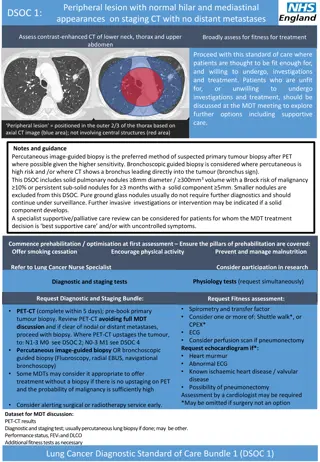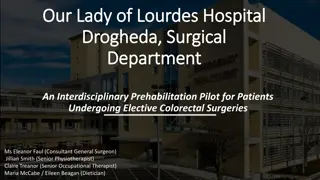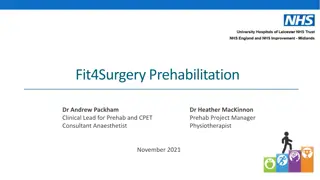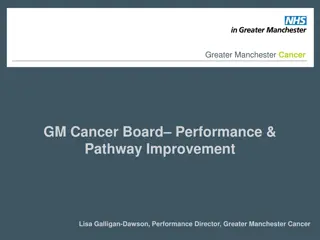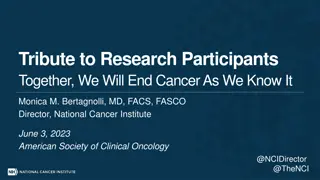Enhancing Cancer Care Pathways Through Prehabilitation Principles and Guidance
Empowering individuals with cancer to improve their physical and mental well-being, prehabilitation plays a crucial role in enhancing treatment outcomes and quality of life. From personalized care plans to early interventions overseen by multidisciplinary teams, this approach fosters healthy behaviors and tailored support, leading to visible benefits in as little as two weeks. By integrating prehabilitation into the cancer care pathway, screening for holistic needs, monitoring interventions effectively, and optimizing service development, healthcare systems can ensure efficient, timely, and patient-centered care delivery.
Download Presentation

Please find below an Image/Link to download the presentation.
The content on the website is provided AS IS for your information and personal use only. It may not be sold, licensed, or shared on other websites without obtaining consent from the author.If you encounter any issues during the download, it is possible that the publisher has removed the file from their server.
You are allowed to download the files provided on this website for personal or commercial use, subject to the condition that they are used lawfully. All files are the property of their respective owners.
The content on the website is provided AS IS for your information and personal use only. It may not be sold, licensed, or shared on other websites without obtaining consent from the author.
E N D
Presentation Transcript
Image result for macmillan logo Principles and guidance for prehabilitation within the Principles and guidance for prehabilitation within the support and management of people with cancer support and management of people with cancer Catherine Neck Clinical Project Manager, South, Central and West Commissioning Support Unit 4thMarch 2020
empowers people with cancer to enhance their own physical and mental health and well-being and thereby supports them to live life as fully as they can. The purpose The purpose of of prehabilitation prehabilitation in cancer in cancer benefits can be seen in as little as 2 weeks. is part of a continuum to rehabilitation. enables people with cancer to prepare for treatment through promoting healthy behaviours and through individualised needs-based prescribing of exercise, nutrition and psychological interventions.
Variable Control Intervention p n=63 n=62 Hospital LOS 13 (20) 8 (8) 0.078 ICU LOS 4 (13) 1 (2) 0.078 Surgical re-intervention 6 (10%) 2 (3%) 0.273 Patients with complications 39 (62%) 19 (31%) 0.001 Complications per patient 1.4 (1.6) 0.5 (1.0) 0.001 Mortality 1 (2%) 1 (2%) 1.000 Barberan-Garcia Annals of Surgery 2017
Prehabilitation in the cancer care pathway Personalised prehabilitation care plan Overseen by cancer MDTs Interventions should start as early as possible
Screening for prehabilitation Image result for clinical assessment of holistic needs
Prehabilitation interventions Prehabilitation interventions Monitoring of interventions should be proportionate to need. Universal interventions should be self-monitored and recorded via the HNA or equivalent process. Targeted and specialist interventions should be monitored for adherence and effectiveness using appropriate validated measures.
Service development The principal focus should be on optimising the efficiency and timeliness of current pathways from the moment of consideration of treatment onwards, without unnecessarily delaying scheduled treatment.
Up to ~50 days 2-14 days First formal physiological assessment Symptom GP referral Diagnostic tests / tumour staging UHS clinic Surgical clinic Pre-assessment clinic MDT Surgery Contemplation of surgery Previous Cancer Pre-Op Pathway at University Hospital Southampton
Up to 62 days Symptom GP referral Diagnostic tests / tumour staging Patient staging with CPET UHS clinic Pre-assessment Clinic final preparations Surgical clinic Stratified perioperative package MDT Contemplation of surgery Cheap & simple risk screening Surgery School patient education /exercise intervention /smoking cessation / group support Bolt-on s as needed anaemia management / comprehensive geriatric assessment / renal, cardiac, respiratory optimisation Low risk Medium risk High risk High Risk Clinic risk discussion / collaborative decision making with MDT / tailored medical interventions New Pre-op Pathway



